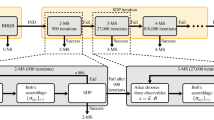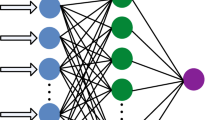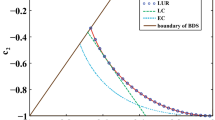Abstract
We apply the artificial neural network to quantify two-qubit steerability based on the steerable weight, which can be computed through semidefinite programming. Due to the fact that the optimal measurement strategy is unknown, it is still very difficult and time-consuming to efficiently obtain the steerability for an arbitrary quantum state. In this work, we show the method via machine learning technique which provides an effective way to quantify steerability. Furthermore, the generalization ability of the trained model is also demonstrated by applying to the Werner state and that in dephasing noise channel. Our findings provide an new way to obtain steerability efficiently and accurately, revealing effective application of the machine learning method on exploring quantum steering.






Similar content being viewed by others
Explore related subjects
Discover the latest articles, news and stories from top researchers in related subjects.References
Schrodinger, E.: Discussion of probability relations between separated systems. Math. Proc. Camb. Philos. Soc. 31(4), 555 (1935). https://doi.org/10.1017/S0305004100013554
Einstein, A., Podolsky, B., Rosen, N.: Can quantum-mechanical description of physical reality be considered complete? Phys. Rev. 47, 777 (1935). https://doi.org/10.1103/PhysRev.47.777
Wiseman, H.M., Jones, S.J., Doherty, A.C.: Steering, entanglement, nonlocality, and the Einstein–Podolsky–Rosen paradox. Phys. Rev. Lett. 98, 140402 (2007). https://doi.org/10.1103/PhysRevLett.98.140402
Branciard, C., Cavalcanti, E.G., Walborn, S.P., Scarani, V., Wiseman, H.M.: One-sided device-independent quantum key distribution: security, feasibility, and the connection with steering. Phys. Rev. A 85, 010301 (2012). https://doi.org/10.1103/PhysRevA.85.010301
Acín, A., Brunner, N., Gisin, N., Massar, S., Pironio, S., Scarani, V.: Device-independent security of quantum cryptography against collective attacks. Phys. Rev. Lett. 98, 230501 (2007). https://doi.org/10.1103/PhysRevLett.98.230501
Passaro, E., Cavalcanti, D., Skrzypczyk, P., Acín, A.: Optimal randomness certification in the quantum steering and prepare-and-measure scenarios. New J. Phys. 17(11), 113010 (2015). https://doi.org/10.1088/1367-2630/17/11/113010
Piani, M., Watrous, J.: Necessary and sufficient quantum information characterization of Einstein–Podolsky–Rosen steering. Phys. Rev. Lett. 114, 060404 (2015). https://doi.org/10.1103/PhysRevLett.114.060404
Cavalcanti, E.G., Jones, S.J., Wiseman, H.M., Reid, M.D.: Experimental criteria for steering and the Einstein–Podolsky–Rosen paradox. Phys. Rev. A 80, 032112 (2009). https://doi.org/10.1103/PhysRevA.80.032112
Walborn, S.P., Salles, A., Gomes, R.M., Toscano, F., Souto Ribeiro, H.: Revealing hidden Einstein–Podolsky–Rosen nonlocality. Phys. Rev. Lett. 106, 130402 (2011). https://doi.org/10.1103/PhysRevLett.106.130402
Schneeloch, J., Broadbent, C.J., Walborn, S.P., Cavalcanti, E.G., Howell, J.C.: Einstein–Podolsky–Rosen steering inequalities from entropic uncertainty relations. Phys. Rev. A 87, 062103 (2013). https://doi.org/10.1103/PhysRevA.87.062103
Pramanik, T., Kaplan, M., Majumdar, A.S.: Fine-grained Einstein–Podolsky–Rosen—steering inequalities. Phys. Rev. A 90, 050305 (2014). https://doi.org/10.1103/PhysRevA.90.050305
Kogias, I., Skrzypczyk, P., Cavalcanti, D., Acín, A., Adesso, G.: Hierarchy of steering criteria based on moments for all bipartite quantum systems. Phys. Rev. Lett. 115, 210401 (2015). https://doi.org/10.1103/PhysRevLett.115.210401
Das, D., Sasmal, S., Roy, S.: Detecting Einstein–Podolsky–Rosen steering through entanglement detection. Phys. Rev. A 99, 052109 (2019). https://doi.org/10.1103/PhysRevA.99.052109
Chen, C., Ren, C., Ye, X.J., Chen, J.L.: Mapping criteria between nonlocality and steerability in qudit–qubit systems and between steerability and entanglement in qubit–qudit systems. Phys. Rev. A 98, 052114 (2018). https://doi.org/10.1103/PhysRevA.98.052114
Yang, H., Ding, Z.Y., Wang, D., Yuan, H., Song, X.K., Yang, J., Zhang, C.J., Ye, L.: Experimental observation of Einstein–Podolsky–Rosen steering via entanglement detection. Phys. Rev. A 101, 042115 (2020). https://doi.org/10.1103/PhysRevA.101.042115
Hsieh, C.Y., Liang, Y.C., Lee, R.K.: Quantum steerability: characterization, quantification, superactivation, and unbounded amplification. Phys. Rev. A 94, 062120 (2016). https://doi.org/10.1103/PhysRevA.94.062120
Das, D., Datta, S., Jebaratnam, C., Majumdar, A.S.: Cost of Einstein–Podolsky–Rosen steering in the context of extremal boxes. Phys. Rev. A 97, 022110 (2018). https://doi.org/10.1103/PhysRevA.97.022110
Kaur, E., Wang, X., Wilde, M.M.: Conditional mutual information and quantum steering. Phys. Rev. A 96, 022332 (2017). https://doi.org/10.1103/PhysRevA.96.022332
Ku, H.Y., Chen, S.L., Budroni, C., Miranowicz, A., Chen, Y.N., Nori, F.: Einstein–Podolsky–Rosen steering: its geometric quantification and witness. Phys. Rev. A 97, 022338 (2018). https://doi.org/10.1103/PhysRevA.97.022338
Skrzypczyk, P., Navascués, M., Cavalcanti, D.: Quantifying Einstein–Podolsky–Rosen steering. Phys. Rev. Lett. 112, 180404 (2014). https://doi.org/10.1103/PhysRevLett.112.180404
Vandenberghe, L., Boyd, S.: Semidefinite programming. SIAM Rev. 38(1), 49 (1996). https://doi.org/10.1137/1038003
Cavalcanti, D., Skrzypczyk, P.: Quantum steering: a review with focus on semidefinite programming. Rep. Prog. Phys. 80(2), 024001 (2016). https://doi.org/10.1088/1361-6633/80/2/024001
Bishop, C.: Pattern Recognition and Machine Learning. Springer, New York (2006)
Carleo, G., Cirac, I., Cranmer, K., Daudet, L., Schuld, M., Tishby, N., Vogt-Maranto, L., Zdeborová, L.: Machine learning and the physical sciences. Rev. Mod. Phys. 91, 045002 (2019). https://doi.org/10.1103/RevModPhys.91.045002
Ch’ng, K., Carrasquilla, J., Melko, R.G., Khatami, E.: Machine learning phases of strongly correlated fermions. Phys. Rev. X 7, 031038 (2017). https://doi.org/10.1103/PhysRevX.7.031038
Yoshioka, N., Akagi, Y., Katsura, H.: Learning disordered topological phases by statistical recovery of symmetry. Phys. Rev. B 97, 205110 (2018). https://doi.org/10.1103/PhysRevB.97.205110
Torlai, G., Mazzola, G., Carrasquilla, J., Troyer, M.: Neural-network quantum state tomography. Nat. Phys 14, 447 (2018). https://doi.org/10.1038/s41567-018-0048-5
Deng, D.L.: Machine learning detection of bell nonlocality in quantum many-body systems. Phys. Rev. Lett. 120, 240402 (2018). https://doi.org/10.1103/PhysRevLett.120.240402
Canabarro, A., Brito, S., Chaves, R.: Machine learning nonlocal correlations. Phys. Rev. Lett. 122, 200401 (2019). https://doi.org/10.1103/PhysRevLett.122.200401
Ren, C., Chen, C.: Steerability detection of an arbitrary two-qubit state via machine learning. Phys. Rev. A 100, 022314 (2019). https://doi.org/10.1103/PhysRevA.100.022314
Nielsen, M.A.: Neural Networks and Deep Learning. Determination Press, New York (2015)
Werner, R.F.: Quantum states with Einstein–Podolsky–Rosen correlations admitting a hidden-variable model. Phys. Rev. A 40, 4277 (1989). https://doi.org/10.1103/PhysRevA.40.4277
Nielsen, M.A., Chuang, I.L.: Quantum Computation and Quantum Information. Cambridge University Press, Cambridge (2010)
Acknowledgements
This work was supported by the National Natural Science Foundation of China under Grant Nos. 11805065 and 11504106, the Natural Science and Technology Foundation of Guizhou Province under Grant No. [2017]7343, the Key laboratory of low dimensional condensed matter physics of higher educational institution of Guizhou province (Grant No.[2016]002) and also by the Fundamental Research Funds for the Central Universities (Grant No. 2018072).
Author information
Authors and Affiliations
Corresponding author
Additional information
Publisher's Note
Springer Nature remains neutral with regard to jurisdictional claims in published maps and institutional affiliations.
Rights and permissions
About this article
Cite this article
Zhang, YQ., Yang, LJ., He, QL. et al. Machine learning on quantifying quantum steerability. Quantum Inf Process 19, 263 (2020). https://doi.org/10.1007/s11128-020-02769-4
Received:
Accepted:
Published:
DOI: https://doi.org/10.1007/s11128-020-02769-4




